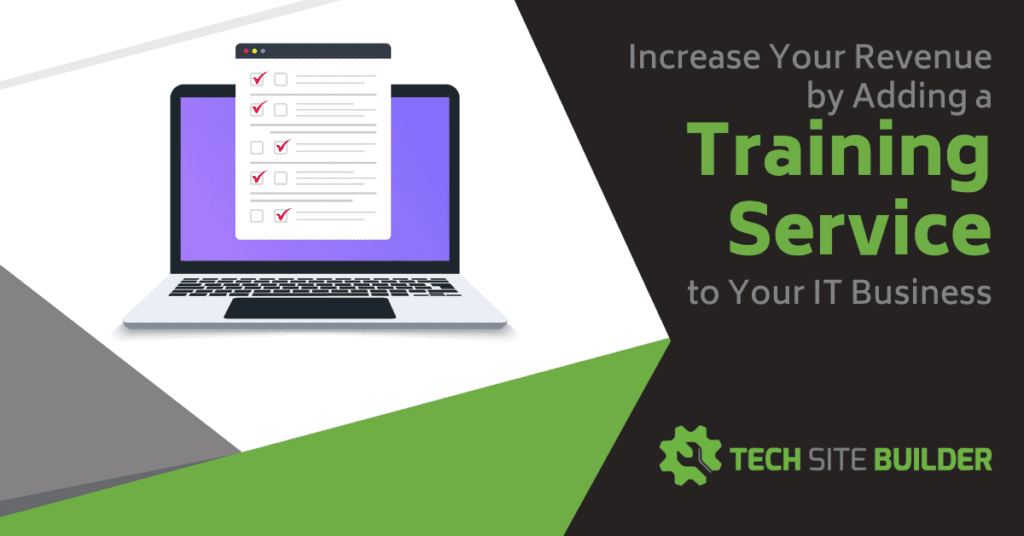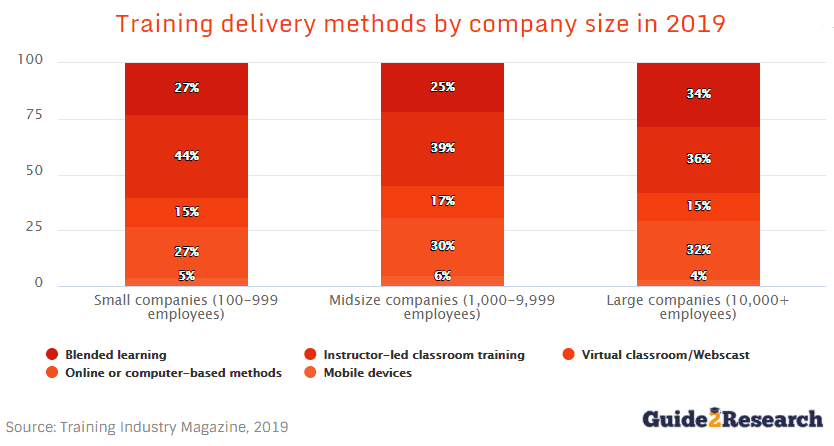
Providing IT support and managed services is a competitive field. One way to make yourself stand out and increase revenue is to offer services your competitors don’t.
One of the obvious services that most MSPs are already well-suited to provide is training. Corporate training for cybersecurity, new software, and technology enablement is something most companies are looking for at some point.
By putting together a training services offering with the right marketing, you can drive a healthy new revenue channel for your IT business.
What’s Involved With Offering Corporate & Business Training?
A full 70% of employees say they don’t have mastery of the skills needed to do their jobs. And in today’s technology-driven world, most of those skills are dealing with computers, IoT devices, and software applications.
Beyond learning how to get around in platforms like Microsoft 365, Google Workspace, and Salesforce, employees are on the front line when it comes to cybersecurity but woefully undertrained in many cases.
Studies show that when employees are properly trained in things like identifying phishing emails and password security, cybersecurity risk can be reduced by as much as 70%.
The increase in phishing and ransomware attacks throughout the pandemic has brought renewed interest by companies in ongoing employee security awareness training. This means an opening for your company to capture more sales and leads and cross-market your IT business services.
For example:
- Offer a training add-on with your managed services packages.
- Market your managed cybersecurity services to corporate training clients.
- Give a discount on IT support or repairs to companies that use your training services.

So, how do you get started with adding a training service to your IT business? I’ll go through several steps below to get you started!
Choose Your Training Topics
First, you’ll want to decide on the training topics that you feel comfortable offering and that are in demand.
Of course, you’ll want to stay in the technology realm, but that doesn’t mean you can’t put a unique twist on it to cover some of the more popular topics. For example, leadership development is a popular type of training that companies spend money on.
While offering general leadership training may not be in your wheelhouse, you can offer something like “How Leaders Can Use Microsoft Viva to Enhance Their Success.”
Keep your mind open when you consider training topics because you’ll want to make sure you’re offering what customers want. You might even survey your current clients on the types of training they’d like to see if your company were to add training to your services.
Some of the popular topics to consider:
- Cybersecurity Awareness (this is a “no-brainer” for IT companies. It can also encompass many different topics)
- Microsoft Application Training
- Specialized Software Training (Salesforce, Microsoft Teams, QuickBooks, etc.)
- Remote Teams (this can include multiple topics, like video presentation basics and device security)
- Change Management Technology Training (change management is a hot field right now and employee training is a big part of a successful company transition)
According to Zoe Training, here are some of the most requested types of company training. I’ve added how you can parlay that into an IT business focus.
- Employee Engagement (Microsoft Viva training will fit in perfectly with this topic)
- Time Management (Create courses focused on productivity enhancement using technology)
- Communication (Training for MS Teams, Slack, etc.)
- Customer Service (Training for chatbots, customer service over social media, etc.)
- Virtual Teams (As mentioned above, there are multiple topics you can incorporate into ongoing virtual team training)
Develop or Leverage Online Training Curriculum
Once you’ve chosen the topics you want to offer for your training services, you need to put together the training program curriculum.
This typically includes both a syllabus of the course and a PPT/PDF that you’ll use as a teaching aid that students can reference offline.
Additionally, you should have a quiz or test that will confirm whether or not students have properly retained the information.
The thought of putting all this together yourself from scratch is enough to turn you off to the idea of offering training services. But there are multiple online resources you can leverage for training curriculum, so you’re not starting from square one.
All you would need to do is tweak and personalize the training materials for your business.
Here are a few ideas of where to get training curriculum and ideas for how to present your training courses:
- Links to Multiple Training Resources from NIST
- Microsoft Online Training Events
- Trainer Bubble
- Webroot Security Awareness Training
- CFISA Cybersecurity Training
Which Training Delivery Options Will You Offer?
How are you going to deliver training to your clients? You have a few different options and the more choice you can offer clients, the better chance you have of getting their business.
Standard training delivery types are:
- Instructor-led Classroom: Training in a conference room or classroom that is held in person. (Not as popular since the pandemic but might be making a comeback.)
- Virtual Classroom/Webcast: Another form of instructor-led training, but it’s virtual instead of in-person.
- Online or Software-based Self-Learning: This form of training delivery could include a pre-recorded webcast or online training videos and quizzes. The main difference between this and virtual classroom training is that an instructor is not present in real-time.
- Blended Learning: This includes a combination of any of the above methods. For example, an initial in-person training, followed by virtual webcasts.
- Mobile: This isn’t really a whole different method of training, but it’s important to deliver online training in a way that is mobile-accessible.
According to a pre-pandemic survey by Training Industry Magazine, 44% of small businesses prefer training delivery in a classroom with an instructor, while just 36% of larger companies choose that method, with nearly as many (34%) opting for blended learning, which is a hybrid of in-person and online training.

It’s important to understand the different types of training delivery methods that companies want so you can match your services to their needs. If you’re only offering online training, then you could miss out on a great corporate training account.
If you don’t have the bandwidth to offer in-person training for every session, then consider a blended option where you deliver the first and last session in a series in-person and the other sessions via a live webinar setting.
You want to ensure you’re offering something companies can’t get from subscribing to an online training tool, which is a live technology expert.
Pro-Tip: Provide an option to offer your training courses through Microsoft’s brand new Viva Learning add-on for Teams.
Decide on Technology Tools for Training Delivery
What types of technology are you going to use for training delivery?
Some of the common ones are using a webinar platform to hold virtual training and posting videos online for students to reference.
You’ll need to consider a few things.
Tools Used for In-Person Training
If you’re doing training at a client’s location, you’ll need to have items on hand like a projector, laptop, and possibly a whiteboard.
Also, consider whether employees need to have a PC in front of them to facilitate the training or if you can present on the screen and have them practice once they get back to their desks.
Tools for Virtual Training
You want to ensure that you have a reliable online meeting tool that enables interaction between the instructor and students and is easy for everyone to access on PC or mobile.
You may also want to offer a few different options, for example, Zoom or Teams, as many companies may already be using MS Teams and prefer to conduct training in a tool that employees are familiar with.
Tools for Class Content
Where will you host class content? You don’t want to put your paid-for training up for public consumption on YouTube, so you’ll need to come up with a cloud hosting environment where you plan to keep your training materials to make them accessible to students.
This would be where you host things like:
- Course videos
- PPT/PDF content
- Quizzes/Tests
- Any additional course “extras” like IT security infographics and posters
Tools for Quizzes & Trainee Tracking
If you’re providing a course on employee phishing awareness, how is your client going to know if the material has been absorbed by employees?
You should have a method of quizzing employees and keeping track of their scores. This can be something like Microsoft Forms, which can be delivered online and all results can quickly be exported to Excel.
If you’re using a white-label IT security training program, then it may have testing covered in its options.
Training tracking allows you to provide reporting on your trainees to your client. This is a great way to show the value of your training as well as help them identify outstanding employees who may be scoring highly consistently on different training courses. You can find several training tracking tools online. Look for those that have analytics reporting included to save yourself some time.
Market Training to Existing Customers
Once you have your training courses, delivery method(s), and tools figured out, you’ll want to start marketing your training services to generate sales. A great place to start is with existing customers who already believe in your services.
Start promoting your training services through:
- Emails
- Printed promo text on your receipts
- Social media
- When you visit client facilities
You may even want to offer a special introductory discount to encourage signups.
Add Training Services to Your Website
Another important part of your marketing is to add a training services page to your website that explains the courses available, pricing, and your options for delivering the training.
Include some statistics on your page that will help you make the case for the importance of well-trained employees when it comes to cybersecurity and productivity.
Even if you plan to fold your training services in with your managed services plans, you should still create a dedicated page for your training services for search engine optimization and to give customers a deeper dive into your offerings.
Training Services Can Add a New Ongoing Revenue Steam for Your Business
Employee training is always in need, especially when it comes to cybersecurity and technology. This makes training services an excellent add-on to drive more sales for your IT business.
What training services do you offer? Share your tips in the comments.
Speak Your Mind